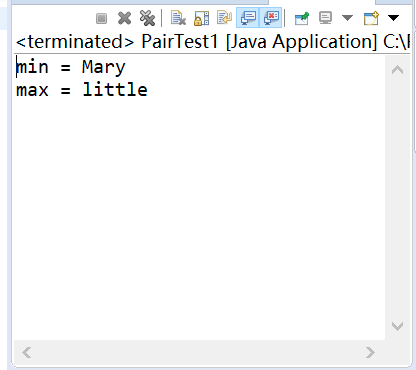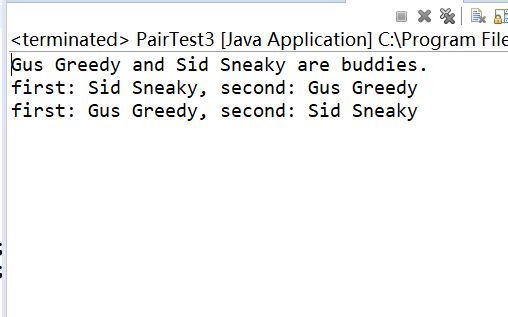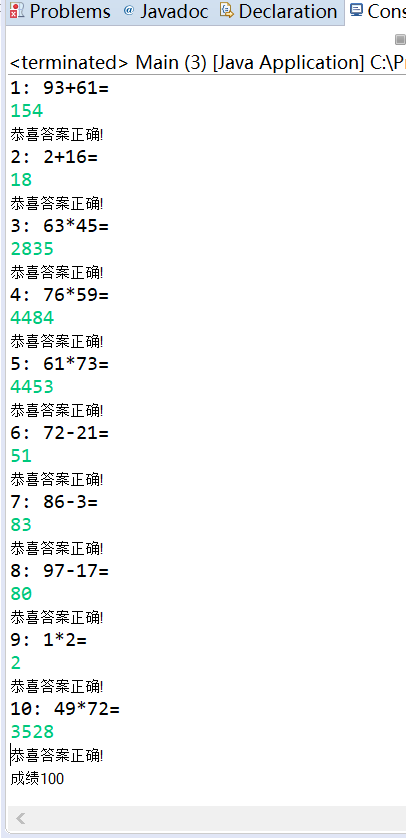第8章泛型程序设计学习总结
第一部分:理论知识
主要内容: 什么是泛型程序设计
泛型类的声明及实例化的方法
泛型方法的定义
泛型接口的定义
泛型类型的继承规则
通配符类型及使用方法
1:泛型类的定义
(1) 一个泛型类(generic class)就是具有一个或多个类型变量的类,即创建用类型作为参数的类。如一个泛型类定义格式如下:class Generics<K,V>其中的K和V是类中的可变类型参数。如:
public class Pair{
private T first;
private T second;
public Pair() {first = null; second = null;}
public Pair(T first, T second) {
this.first = first; this.second = second;
}
public T getFirst() {return first;}
public T getSecond() {return second;}
public void setFirst(T newValue)
{first = newValue;}
public void setSecond(T newValue)
{second = newValue;}
}
(2)Pair类引入了一个类型变量T,用尖括号(<>)括起来,并放在类名的后面。泛型类可以有多个类型变量。例如:public class Pair<t, u=""> { … }
(3) 类定义中的类型变量用于指定方法的返回类型以及域、局部变量的类型。
2.泛型方法的声明
(1)泛型方法
– 除了泛型类外,还可以只单独定义一个方法作为泛型方法,用于指定方法参数或者返回值为泛型类型,留待方法调用时确定。
– 泛型方法可以声明在泛型类中,也可以声明在普通类中。
public class ArrayTool
{
public static void insert(
E[] e, int i)
{
//请自己添加代码
}
public static E valueAt(
E[] e , int i)
{
//请自己添加代码
}
}
3.泛型接口的定义
(1)定义
public interface IPool
{
T get();
int add(T t);
}
(2)实现
public class GenericPool implements IPool
{
…
}
public class GenericPool implements IPool
{
…
}
4.泛型变量的限定
(1) 定义泛型变量的上界
public class NumberGeneric< T extends Number>
(2) 泛型变量上界的说明
上述声明规定了NumberGeneric类所能处理的泛型变量类型需和Number有继承关系;
extends关键字所声明的上界既可以是一个类,也可以是一个接口;
(3)< T extends BoundingType> 表示T应该是绑定类型的子类型。 一个类型变量或通配符可以有多个限定,限定类型用“&”分割。例如:< T extends Comparable & Serializable >
(4) 定义泛型变量的下界
List cards = new ArrayList();
(5) 泛型变量下界的说明
– 通过使用super关键字可以固定泛型参数的类型为某种类型或者其超类
– 当程序希望为一个方法的参数限定类型时,通常可以使用下限通配符
public static void sort(T[] a,Comparator c)
{ …
}
5.通配符类型
通配符
– “?”符号表明参数的类型可以是任何一种类型,它和参数T的含义是有区别的。T表示一种未知类型,而“?”表示任何一种类型。这种通配符一般有以下三种用法:
– 单独的?,用于表示任何类型。
– ? extends type,表示带有上界。
– ? super type,表示带有下界。
第二部分:实验部分
实验十 泛型程序设计技术
实验时间 2018-11-1
1、实验目的与要求
(1) 理解泛型概念;
(2) 掌握泛型类的定义与使用;
(3) 掌握泛型方法的声明与使用;
(4) 掌握泛型接口的定义与实现;
(5)了解泛型程序设计,理解其用途。
2、实验内容和步骤
实验1: 导入第8章示例程序,测试程序并进行代码注释。
测试程序1:
l 编辑、调试、运行教材311、312页 代码,结合程序运行结果理解程序;
l 在泛型类定义及使用代码处添加注释;
l 掌握泛型类的定义及使用。
1 package pair1; 2 3 /** 4 * @version 1.01 2012-01-26 5 * @author Cay Horstmann 6 */ 7 public class PairTest1 8 { 9 public static void main(String[] args) 10 { 11 String[] words = { "Mary", "had", "a", "little", "lamb" }; 12 //ArrayAlg调用静态方法minmax; 13 Pair<String> mm = ArrayAlg.minmax(words); 14 15 System.out.println("min = " + mm.getFirst()); 16 System.out.println("max = " + mm.getSecond()); 17 } 18 } 19 20 class ArrayAlg 21 { 22 /** 23 * Gets the minimum and maximum of an array of strings. 24 * @param a an array of strings 25 * @return a pair with the min and max value, or null if a is null or empty 26 */ 27 public static Pair<String> minmax(String[] a)//定义静态泛型方法,将类型变量实例化为String; 28 { 29 if (a == null || a.length == 0) return null; 30 String min = a[0]; 31 String max = a[0]; 32 for (int i = 1; i < a.length; i++) 33 { 34 if (min.compareTo(a[i]) > 0) min = a[i]; 35 if (max.compareTo(a[i]) < 0) max = a[i]; 36 } 37 return new Pair<>(min, max);//返回一个实例化后的类对象; 38 } 39 }
1 package pair1; 2 3 /** 4 * @version 1.00 2004-05-10 5 * @author Cay Horstmann 6 */ 7 public class Pair<T> //定义泛型类,类型变量为T; 8 { 9 private T first; 10 private T second; 11 12 public Pair() { first = null; second = null; } 13 // 构造泛型方法,构造方法的入口参数(first, second)类型为泛型T; 14 public Pair(T first, T second) { this.first = first; this.second = second; } 15 //定义泛型方法,类型变量T指定了访问方法的返回值和入口参数的类型; 16 public T getFirst() { return first; } 17 public T getSecond() { return second; } 18 //泛型方法,构造方法的入口参数类型为泛型T; 19 public void setFirst(T newValue) { first = newValue; } 20 public void setSecond(T newValue) { second = newValue; } 21 }

测试程序2:
l 编辑、调试运行教材315页 PairTest2,结合程序运行结果理解程序;
l 在泛型程序设计代码处添加相关注释;
l 掌握泛型方法、泛型变量限定的定义及用途。
1 package pair2; 2 3 /** 4 * @version 1.00 2004-05-10 5 * @author Cay Horstmann 6 */ 7 public class Pair<T> //定义泛型类,类型变量为T; 8 { 9 private T first; 10 private T second; 11 12 public Pair() { first = null; second = null; } 13 // 构造泛型方法,构造方法的入口参数(first, second)类型为泛型T; 14 public Pair(T first, T second) { this.first = first; this.second = second; } 15 //定义泛型方法,类型变量T指定了访问方法的返回值和入口参数的类型; 16 public T getFirst() { return first; } 17 public T getSecond() { return second; } 18 //泛型方法,构造方法的入口参数类型为泛型T; 19 public void setFirst(T newValue) { first = newValue; } 20 public void setSecond(T newValue) { second = newValue; } 21 }
1 package pair2; 2 //import PairTest1.Pair; 3 import java.time.*; 4 5 /** 6 * @version 1.02 2015-06-21 7 * @author Cay Horstmann 8 */ 9 public class PairTest2 10 { 11 public static void main(String[] args) 12 { 13 LocalDate[] birthdays = 14 { 15 LocalDate.of(1906, 12, 9), // G. Hopper 16 LocalDate.of(1815, 12, 10), // A. Lovelace 17 LocalDate.of(1903, 12, 3), // J. von Neumann 18 LocalDate.of(1910, 6, 22), // K. Zuse 19 }; 20 //ArrayAlg调用静态方法minmax, 21 Pair<LocalDate> mm = ArrayAlg.minmax(birthdays); 22 System.out.println("min = " + mm.getFirst()); 23 System.out.println("max = " + mm.getSecond()); 24 } 25 } 26 27 class ArrayAlg 28 { 29 /** 30 Gets the minimum and maximum of an array of objects of type T. 31 @param a an array of objects of type T 32 @return a pair with the min and max value, or null if a is 33 null or empty 34 */ 35 //构造泛型方法;限定类型变量,类型变量T是Comparable类的子类, 36 public static <T extends Comparable> Pair<T> minmax(T[] a) 37 { 38 if (a == null || a.length == 0) return null; 39 T min = a[0]; 40 T max = a[0]; 41 for (int i = 1; i < a.length; i++) 42 { 43 if (min.compareTo(a[i]) > 0) min = a[i]; 44 if (max.compareTo(a[i]) < 0) max = a[i]; 45 } 46 return new Pair<>(min, max);//返回一个实例化泛型Pair类对象; 47 } 48 }

测试程序3:
l 用调试运行教材335页 PairTest3,结合程序运行结果理解程序;
l 了解通配符类型的定义及用途。
1 package pair3; 2 3 import java.time.*; 4 5 public class Employee 6 { 7 private String name; 8 private double salary; 9 private LocalDate hireDay; 10 11 public Employee(String name, double salary, int year, int month, int day) 12 { 13 this.name = name; 14 this.salary = salary; 15 hireDay = LocalDate.of(year, month, day); 16 } 17 18 public String getName() 19 { 20 return name; 21 } 22 23 public double getSalary() 24 { 25 return salary; 26 } 27 28 public LocalDate getHireDay() 29 { 30 return hireDay; 31 } 32 33 public void raiseSalary(double byPercent) 34 { 35 double raise = salary * byPercent / 100; 36 salary += raise; 37 } 38 }
1 package pair3; 2 3 public class Manager extends Employee// Manager继承父类 Employee; 4 { 5 private double bonus; 6 7 /** 8 @param name the employee's name 9 @param salary the salary 10 @param year the hire year 11 @param month the hire month 12 @param day the hire day 13 */ 14 public Manager(String name, double salary, int year, int month, int day) 15 { 16 super(name, salary, year, month, day); 17 bonus = 0; 18 } 19 20 public double getSalary() 21 { 22 double baseSalary = super.getSalary(); 23 return baseSalary + bonus; 24 } 25 26 public void setBonus(double b) 27 { 28 bonus = b; 29 } 30 31 public double getBonus() 32 { 33 return bonus; 34 } 35 }
1 package pair3; 2 3 /** 4 * @version 1.00 2004-05-10 5 * @author Cay Horstmann 6 */ 7 public class Pair<T> //定义泛型类,类型变量为T; 8 { 9 private T first; 10 private T second; 11 12 public Pair() { first = null; second = null; } 13 // 构造泛型方法,构造方法的入口参数(first, second)类型为泛型T; 14 public Pair(T first, T second) { this.first = first; this.second = second; } 15 //定义泛型方法,类型变量T指定了访问方法的返回值和入口参数的类型; 16 public T getFirst() { return first; } 17 public T getSecond() { return second; } 18 //泛型方法,构造方法的入口参数类型为泛型T; 19 public void setFirst(T newValue) { first = newValue; } 20 public void setSecond(T newValue) { second = newValue; } 21 }
1 package pair3; 2 3 /** 4 * @version 1.01 2012-01-26 5 * @author Cay Horstmann 6 */ 7 public class PairTest3 8 { 9 public static void main(String[] args) 10 { 11 Manager ceo = new Manager("Gus Greedy", 800000, 2003, 12, 15); 12 Manager cfo = new Manager("Sid Sneaky", 600000, 2003, 12, 15); 13 //创建Pair泛型类对象(泛型变量T默认为int型,并将其传递给类型变量T为Manager的类变量buddies; 14 Pair<Manager> buddies = new Pair<>(ceo, cfo); 15 printBuddies(buddies); 16 17 ceo.setBonus(1000000); 18 cfo.setBonus(500000); 19 Manager[] managers = { ceo, cfo }; 20 21 Pair<Employee> result = new Pair<>();//创建一个Pair类对象,并将其传递给类型变量T为Employee的类变量 result; 22 minmaxBonus(managers, result); 23 System.out.println("first: " + result.getFirst().getName() 24 + ", second: " + result.getSecond().getName()); 25 maxminBonus(managers, result); 26 System.out.println("first: " + result.getFirst().getName() 27 + ", second: " + result.getSecond().getName()); 28 } 29 30 //?:下限通配符;限定类型变量的下界为Employee类; 31 public static void printBuddies(Pair<? extends Employee> p) { 32 Employee first = p.getFirst(); 33 Employee second = p.getSecond(); 34 System.out.println(first.getName() + " and " + second.getName() + " are buddies."); 35 } 36 //?:下限通配符;限定类型变量的下界为Manager类; 37 public static void minmaxBonus(Manager[] a, Pair<? super Manager> result) 38 { 39 if (a.length == 0) return; 40 Manager min = a[0]; 41 Manager max = a[0]; 42 for (int i = 1; i < a.length; i++) 43 { 44 if (min.getBonus() > a[i].getBonus()) min = a[i]; 45 if (max.getBonus() < a[i].getBonus()) max = a[i]; 46 } 47 result.setFirst(min); 48 result.setSecond(max); 49 } 50 //?:下限通配符;限定泛型类Pair类型变量的下界为Manager类; 51 public static void maxminBonus(Manager[] a, Pair<? super Manager> result) 52 { 53 minmaxBonus(a, result); 54 PairAlg.swapHelper(result); //swapHelper捕获通配符类型 ; 55 } 56 // 不能写: public static <T super manager> ... 57 } 58 59 class PairAlg 60 { 61 public static boolean hasNulls(Pair<?> p)//限定泛型类Pair类型变量的下界为p; 62 { 63 return p.getFirst() == null || p.getSecond() == null; 64 } 65 66 public static void swap(Pair<?> p) { swapHelper(p); } 67 68 public static <T> void swapHelper(Pair<T> p) 69 { 70 T t = p.getFirst(); 71 p.setFirst(p.getSecond()); 72 p.setSecond(t); 73 } 74 }

实验2:编程练习:
编程练习1:实验九编程题总结
l 实验九编程练习1总结(从程序总体结构说明、模块说明,目前程序设计存在的困难与问题三个方面阐述)。

1 package shiyan9; 2 import java.io.BufferedReader; 3 import java.io.File; 4 import java.io.FileInputStream; 5 import java.io.FileNotFoundException; 6 import java.io.IOException; 7 import java.io.InputStreamReader; 8 import java.util.ArrayList; 9 import java.util.Arrays; 10 import java.util.Collections; 11 import java.util.Scanner; 12 13 14 public class Search{ 15 16 private static ArrayList<Person> Personlist1; 17 public static void main(String[] args) { 18 19 20 21 Personlist1 = new ArrayList<>(); 22 23 Scanner scanner = new Scanner(System.in); 24 File file = new File("E:\面向对象程序设计Java\实验\实验六\身份证号.txt"); 25 26 try { 27 FileInputStream F = new FileInputStream(file); 28 BufferedReader in = new BufferedReader(new InputStreamReader(F)); 29 String temp = null; 30 while ((temp = in.readLine()) != null) { 31 32 Scanner linescanner = new Scanner(temp); 33 34 linescanner.useDelimiter(" "); 35 String name = linescanner.next(); 36 String id = linescanner.next(); 37 String sex = linescanner.next(); 38 String age = linescanner.next(); 39 String place =linescanner.nextLine(); 40 Person Person = new Person(); 41 Person.setname(name); 42 Person.setid(id); 43 Person.setsex(sex); 44 int a = Integer.parseInt(age); 45 Person.setage(a); 46 Person.setbirthplace(place); 47 Personlist1.add(Person); 48 49 } 50 } catch (FileNotFoundException e) { 51 System.out.println("查找不到信息"); 52 e.printStackTrace(); 53 } catch (IOException e) { 54 System.out.println("信息读取有误"); 55 e.printStackTrace(); 56 } 57 boolean isTrue = true; 58 while (isTrue) { 59 System.out.println("******************************************"); 60 System.out.println("1:按姓名字典顺序输出信息;"); 61 System.out.println("2:查询最大年龄与最小年龄人员信息;"); 62 System.out.println("3:按省份找你的同乡;"); 63 System.out.println("4:输入你的年龄,查询年龄与你最近人的信息;"); 64 System.out.println("5:退出"); 65 System.out.println("******************************************"); 66 int type = scanner.nextInt(); 67 switch (type) { 68 case 1: 69 Collections.sort(Personlist1); 70 System.out.println(Personlist1.toString()); 71 break; 72 case 2: 73 74 int max=0,min=100;int j,k1 = 0,k2=0; 75 for(int i=1;i<Personlist1.size();i++) 76 { 77 j=Personlist1.get(i).getage(); 78 if(j>max) 79 { 80 max=j; 81 k1=i; 82 } 83 if(j<min) 84 { 85 min=j; 86 k2=i; 87 } 88 89 } 90 System.out.println("年龄最大:"+Personlist1.get(k1)); 91 System.out.println("年龄最小:"+Personlist1.get(k2)); 92 break; 93 case 3: 94 System.out.println("place?"); 95 String find = scanner.next(); 96 String place=find.substring(0,3); 97 String place2=find.substring(0,3); 98 for (int i = 0; i <Personlist1.size(); i++) 99 { 100 if(Personlist1.get(i).getbirthplace().substring(1,4).equals(place)) 101 { 102 System.out.println("你的同乡:"+Personlist1.get(i)); 103 } 104 } 105 106 break; 107 case 4: 108 System.out.println("年龄:"); 109 int yourage = scanner.nextInt(); 110 int close=ageclose(yourage); 111 int d_value=yourage-Personlist1.get(close).getage(); 112 System.out.println(""+Personlist1.get(close)); 113 114 break; 115 case 5: 116 isTrue = false; 117 System.out.println("再见!"); 118 break; 119 default: 120 System.out.println("输入有误"); 121 } 122 } 123 } 124 public static int ageclose(int age) { 125 int m=0; 126 int max=53; 127 int d_value=0; 128 int k=0; 129 for (int i = 0; i < Personlist1.size(); i++) 130 { 131 d_value=Personlist1.get(i).getage()-age; 132 if(d_value<0) d_value=-d_value; 133 if (d_value<max) 134 { 135 max=d_value; 136 k=i; 137 } 138 139 } return k; 140 141 } 142 143 144 145 }

1 package shiyan9; 2 3 4 public class Person implements Comparable<Person> { 5 private String name; 6 private String id; 7 private int age; 8 private String sex; 9 private String birthplace; 10 11 public String getname() { 12 return name; 13 } 14 public void setname(String name) { 15 this.name = name; 16 } 17 public String getid() { 18 return id; 19 } 20 public void setid(String id) { 21 this.id= id; 22 } 23 public int getage() { 24 25 return age; 26 } 27 public void setage(int age) { 28 // int a = Integer.parseInt(age); 29 this.age= age; 30 } 31 public String getsex() { 32 return sex; 33 } 34 public void setsex(String sex) { 35 this.sex= sex; 36 } 37 public String getbirthplace() { 38 return birthplace; 39 } 40 public void setbirthplace(String birthplace) { 41 this.birthplace= birthplace; 42 } 43 44 public int compareTo(Person o) { 45 return this.name.compareTo(o.getname()); 46 47 } 48 49 public String toString() { 50 return name+" "+sex+" "+age+" "+id+" "; 51 52 } 53 54 55 56 }
(1)编程练习1总结:
程序总体结构:主类(Search)和接口(Person);
模块说明:(1)主类Search:读取文件模块;
Try/catch模块:监视可能出现的异常;捕捉处理异常;
Switch/case模块匹配选择5种具体操作;
(2)接口(Person):
属性声明模块;
构造方法模块:getname,setname, getid,setid,getage,setage,getsex,setsex,getbirthplace,setbirthplace,compareTo等;
目前存在的困难与问题: 文件读取路径的设置影响到能否找到文件;
不论是语法,还是主要的技术(如接口)方面不是娴熟,有些显而易见的东西不能立马想到;
构想正确的设计思路;
l 实验九编程练习2总结(从程序总体结构说明、模块说明,目前程序设计存在的困难与问题三个方面阐述)。

1 package a; 2 3 import java.io.FileNotFoundException; 4 import java.io.PrintWriter; 5 import java.util.Scanner; 6 7 import org.w3c.dom.css.Counter; 8 9 10 public class Main{ 11 public static void main(String[] args) { 12 13 Scanner in = new Scanner(System.in); 14 counter counter=new counter(); 15 PrintWriter output = null; 16 try { 17 output = new PrintWriter("result.txt"); 18 } catch (Exception e) { 19 //e.printStackTrace(); 20 } 21 int sum = 0; 22 23 for (int i = 1; i < 11; i++) { 24 int a = (int) Math.round(Math.random() * 100); 25 int b = (int) Math.round(Math.random() * 100); 26 int type = (int) Math.round(Math.random() * 4); 27 28 29 switch(type) 30 { 31 case 1: 32 System.out.println(i+": "+a+"/"+b+"="); 33 while(b==0){ 34 b = (int) Math.round(Math.random() * 100); 35 } 36 double c = in.nextDouble(); 37 output.println(a+"/"+b+"="+c); 38 if (c == counter.Chu(a, b)) 39 { 40 sum += 10; 41 System.out.println("恭喜答案正确!"); 42 } 43 else { 44 System.out.println("答案错误!"); 45 } break; 46 47 case 2: 48 System.out.println(i+": "+a+"*"+b+"="); 49 int c1 = in.nextInt(); 50 output.println(a+"*"+b+"="+c1); 51 if (c1 == counter.Cheng(a, b)) { 52 sum += 10; 53 System.out.println("恭喜答案正确!"); 54 } 55 else { 56 System.out.println("答案错误!"); 57 }break; 58 case 3: 59 System.out.println(i+": "+a+"+"+b+"="); 60 int c2 = in.nextInt(); 61 output.println(a+"+"+b+"="+c2); 62 if (c2 == counter.Jia(a, b)) { 63 sum += 10; 64 System.out.println("恭喜答案正确!"); 65 } 66 else { 67 System.out.println("答案错误!"); 68 }break ; 69 case 4: 70 System.out.println(i+": "+a+"-"+b+"="); 71 int c3 = in.nextInt(); 72 output.println(a+"-"+b+"="+c3); 73 if (c3 == counter.Jian(a, b)) { 74 sum += 10; 75 System.out.println("恭喜答案正确!"); 76 } 77 else { 78 System.out.println("答案错误!"); 79 }break ; 80 81 } 82 83 } 84 System.out.println("成绩"+sum); 85 output.println("成绩:"+sum); 86 output.close(); 87 88 } 89 }

1 package a; 2 3 4 public class counter { 5 private int a; 6 private int b; 7 8 public int Jia(int a,int b) 9 { 10 return a+b; 11 } 12 public int Jian(int a,int b) 13 { 14 if((a-b)<0) 15 return 0; 16 else 17 return a-b; 18 } 19 public int Cheng(int a,int b) 20 { 21 return a*b; 22 } 23 public int Chu(int a,int b) 24 { 25 if(b!=0) 26 return a/b; 27 else 28 return 0; 29 } 30 31 32 }
编程练习2总结:
程序结构:主类Main和子类counter两大部分;
模块说明:Main类:
(1) 建文件字符流,文件输出模块,将out结果输出到result.txt中;
(2) try/catch模块捕获处理异常;
(3) Switch//case模块:随机生成a,b两个操作数,匹配选择加减乘除四种具体操作;
(4) 输出总成绩;
子类counter类:
(1) 属性声明;
(2) 构造方法;
程序设计存在的困难与问题:
1.没有全面考虑小学生的实际状况:减法算法结果可能出现负数的情况,以及除法的运算结果直接取整输出,都不符合小学生的学习范围;
2.编程过程中,我在变量的 使用范围中出现了问题;
3.结果输出到文件中;
4.设计思路比较难;
编程练习2:采用泛型程序设计技术改进实验九编程练习2,使之可处理实数四则运算,其他要求不变。
1 package a; 2 3 import java.io.FileNotFoundException; 4 import java.io.PrintWriter; 5 import java.util.Scanner; 6 7 //import org.w3c.dom.css.Counter; 8 9 10 public class Main{ 11 public static void main(String[] args) { 12 13 Scanner in = new Scanner(System.in); 14 counter Counter=new counter(); 15 PrintWriter output = null; 16 try { 17 output = new PrintWriter("result.txt"); 18 } catch (Exception e) { 19 //e.printStackTrace(); 20 } 21 int sum = 0; 22 23 for (int i = 1; i <=10; i++) { 24 int a = (int) Math.round(Math.random() * 100); 25 int b = (int) Math.round(Math.random() * 100); 26 int type = (int) Math.round(Math.random() * 4); 27 28 29 switch(type) 30 { 31 case 1: 32 33 System.out.println(i+": "+a+"/"+b+"="); 34 while(b== 0&& a%b!=0) 35 { 36 b = (int) Math.round(Math.random() * 100); 37 a = (int) Math.round(Math.random() * 100); 38 } 39 40 int c = in.nextInt(); 41 output.println(a+"/"+b+"="+c); 42 if (c == Counter.Chu(a, b)) 43 { 44 sum += 10; 45 System.out.println("恭喜答案正确!"); 46 } 47 else { 48 System.out.println("答案错误!"); 49 } 50 break; 51 52 case 2: 53 System.out.println(i+": "+a+"*"+b+"="); 54 int c1 = in.nextInt(); 55 output.println(a+"*"+b+"="+c1); 56 if (c1 == Counter.Cheng(a, b)) { 57 sum += 10; 58 System.out.println("恭喜答案正确!"); 59 } 60 else { 61 System.out.println("答案错误!"); 62 } 63 break; 64 case 3: 65 System.out.println(i+": "+a+"+"+b+"="); 66 int c2 = in.nextInt(); 67 output.println(a+"+"+b+"="+c2); 68 69 if (c2 == Counter.Jia(a, b)) { 70 sum += 10; 71 System.out.println("恭喜答案正确!"); 72 } 73 else { 74 System.out.println("答案错误!"); 75 } 76 break ; 77 78 79 case 4: 80 81 while (a < b) { 82 int x=0; 83 x=b; 84 b=a; 85 a=x; 86 } 87 System.out.println(i+": "+a+"-"+b+"="); 88 int c3 = in.nextInt(); 89 output.println(a+"-"+b+"="+c3); 90 if (c3 == Counter.Jian(a, b)) 91 { 92 sum += 10; 93 System.out.println("恭喜答案正确!"); 94 } 95 else { 96 System.out.println("答案错误!"); 97 } 98 break ; 99 100 } 101 102 } 103 System.out.println("成绩"+sum); 104 output.println("成绩:"+sum); 105 output.close(); 106 107 } 108 }
1 package a; 2 3 4 public class counter<T>{ 5 private T a; 6 private T b; 7 8 public counter(T a, T b) { 9 this.a = a; 10 this.b = b; 11 } 12 13 public counter() { 14 // TODO Auto-generated constructor stub 15 } 16 17 public int Jia(int a,int b) 18 { 19 return a+b; 20 } 21 public int Jian(int a,int b) 22 { 23 return a-b; 24 25 26 } 27 public int Cheng(int a,int b) 28 { 29 return a*b; 30 } 31 public int Chu(int a,int b) 32 { 33 if (b!= 0 && a%b==0) 34 return a / b; 35 else 36 return 0; 37 38 } 39 40 41 }

主要是对于除法和减法的修改,过滤掉一些不合适的数据;
第三部分:总结
1.上泛型理论课的时候,我以为我掌握的差不多了,用的时候还是多多少少有这样那样的问题,可能有些操作我没练习过也就没发现一些隐藏的问题和疑惑。
2.之前读代码,敲代码的时候虽然会总结,但一直不怎么重视反思总结,但这次这么仔细的,以老师给的这种步骤去重新审视总结,感觉很不错,也积累了一种学习方法;
3.拿到一个问题后的解决思路是非常重要的!!!
